Early ANITA Desktop Calculators
ANITA Mk VII
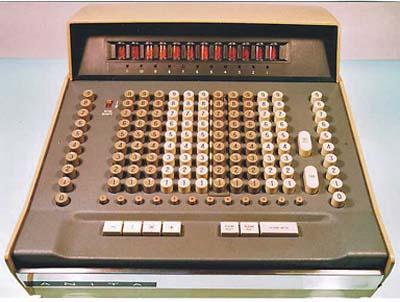
Photograph courtesy of Frank Eggebrecht, via Friedrich Diestelkamp.
ANITA Mk VII
The ANITA Mk VII, made by the Bell Punch Co. of Uxbridge, England, was launched in October 1961[1]. It was sold mainly in continental Europe, and was announced in Germany by the distributor Büromaschinen-Vertriebsgesellschaft m.b.H. Together with the concurrently introduced Anita Mk 8, for the British market, it was the world's first electronic desktop calculator.
Development of the ANITA calculators was started in 1956 under Norbert Kitz (a.k.a. Norman Kitz), who had worked on the pilot version of the ACE (Automatic Computing Engine) computer project in the mid 1940s.
The name ANITA, stands variously for "A New Inspiration To Arithmetic" and "A New Inspiration To Accounting". ANITA became the family name for all the Bell Punch electronic models, and were distributed by Sumlock Anita Ltd.
The photographs show the machine with model/serial number C/VII/0510/A.
The ANITA is a full-keyboard calculator with a 13-digit "Nixie" type tube display, and makes extensive use of cold-cathode vacuum tubes, and an "integrated circuit" of the vacuum tube era - the Dekatron decimal counter tube (see photographs below).
The Mk VII model was sold mainly in continental Europe, especially Germany, Holland, and Belgium.
The manufacturer, the Bell Punch Company, had previously specialised in full-keyboard, "Comptometer"-type, mechanical calculators. The early ANITA models use similar full-keyboards and work in a similar way to a Comptometer, in that just pressing one of the number keys of the main keyboard immediately adds that number to the total being displayed - it is not necessary to press any = key. Addition is very fast since all the fingers can be used to press keys in different columns simultaneously. The full keyboard and instantaneous display of the result means that for addition this type of machine can be much faster than a 10-key calculator, as explained on the Operating a Comptometer page.
For multiplication the X key is pressed, the first number is entered on the main keyboard and the second number is entered in the column of keys on the right.
The position of the decimal point is set by pressing
one of the row of small buttons below the main keyboard.
The column of keys on the far left are the "tabulator keys". Pressing one of these moves the number being displayed so that its decimal point is in the selected position. For example, assume that as a result of previous calculations the display shows 1.53 on the far right of the display, with the decimal point in position 2 between the 2nd and 3rd number indicator tubes. Now, if the next step in the calculation is to add 0.2368 then we cannot do this since the 6 and the 8 are off the keyboard and display to the right. In this case, with the 1.53 being displayed, the tabulator key marked "4" is pressed and the whole number moves on the display to put the decimal point in position 4 so that the display will show 1.5300. The second number, 0.2368, can now be added with no loss of accuracy.
Although the early ANITA models are digital they are do not use binary logic. Instead they are based on an electronic analogue of the mechanism used in the company's mechanical calculators and so use decimal arithmetic. In his symposium paper on these calculators, Norman Kitz said "In many ways, Anita is a small electronic computer working in decimal notation (no binary stunts here!) under the command of the operator."[2]
Initially this model used several Dekatron counter tubes. One produced a series of pulses for continuously scanning the number keys on the keyboard. Another was used to position the decimal point in the display and alter its position during multiplication and division. However, this Dekatron stayed in a fixed state, illuminating one of the decimal point indicators for extended periods which caused problems with sputtering of metal from the energised electrode. The circuit was soon modified to eliminate this Dekatron and cure the problem.
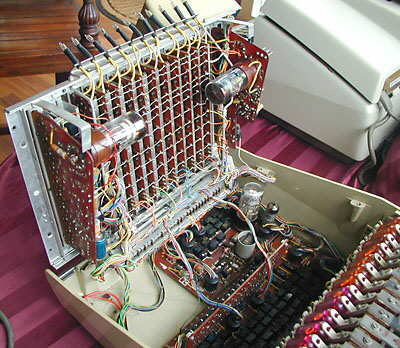
With the keyboard hinged up to the right the electronics inside is revealed. This Mk VII has three Dekatrons, two mounted underneath the keyboard and one on the circuit board at the bottom. The row of small lamps sticking up from the edge of the keyboard are used to provide the decimal point.
Photograph courtesy of Hans Bloemen.
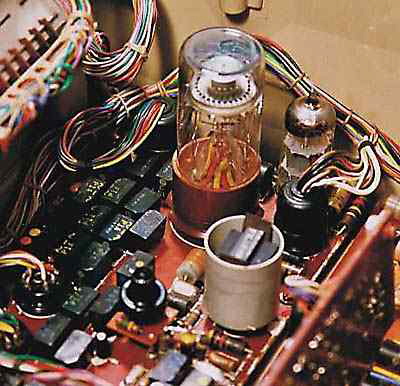
Close-up showing the Dekatron decimal counter tube, used to produce pulses for scanning the number keys, and a vacuum tube to its right.
Photograph courtesy of Frank Eggebrecht, via Friedrich Diestelkamp.
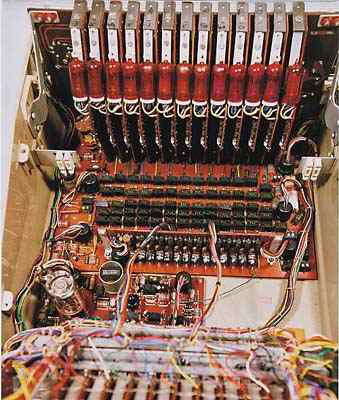
Inside the ANITA Mk VII with the keyboard raised, showing the 13 "Nixie" type number display tubes, each on a separate counter board.
Photograph courtesy of Frank Eggebrecht, via Friedrich Diestelkamp.
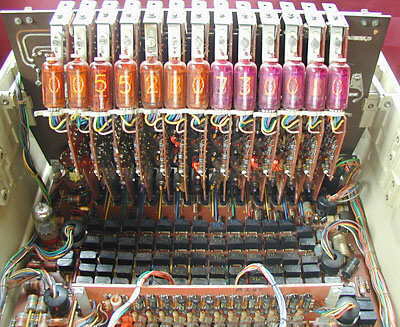
Close up with the machine powered up and numbers being displayed.
Photograph courtesy of Hans Bloemen.
Translation from German of the announcement of the ANITA Mk VII in the journal 'Der Büromaschinen Mechaniker' in November 1961[1]
"Anita" the first portable electronic calculator.
A completely new type of calculating machine
The electronic Büromaschinen-Vertriedsgesellschaft m. b. H., Hamburg 22, Karlstrasse 2, branch in Wuppertal-Barmen, is now bringing the "Anita", the first portable electronic calculating machine, onto the market. "Anita" is the latest product from the Bell Punch Company Ltd, in Uxbridge/England, known for its action-driven Sumlock calculating machines and Plus fast adding machines.
All four types of calculations can be carried out at electronic speed. Addition-subtraction, multiplication and tabulation of calculated values are carried out in 0.035 seconds. The division requires an average computing time of 1 second.
A block of four function keys, on the left under the full keyboard, is used to preset the calculation method. All operands of the four calculation types, with the exception of the multiplier, are entered into the machine via an eleven-digit full keyboard.
To the right of this full keyboard there is a row of keys for entering the multiplier in places. The fast process of the electronic calculation allows all digits of the multiplier to be entered quickly without waiting times.
The results appear in large luminous numbers that are 8 mm wide and 14 mm high. They are exceptionally easy to read.
A particularly convincing solution was found for the comma problem. The multiplication and division factors are both entered with their decimal point. As a result, a illuminated point appears in the correct place.
The position shifting of the calculated results is a special feature of electronic computers. A row of tab keys, located to the left of the full keyboard, allows you to preset the position to which the value should be transferred with its first left of the decimal point. The result moves to the predetermined location in a flash. The comma moves with it. The comma is also correct in the new position. When dividing, the first four digits of the quotient appear in the first four - red - digits of the diagram. The offset portion of the dividend moves out of the display to the left. The remaining remainder is always on the far left in the calculation and display. After writing out and deleting the quotient, the division can be adjusted to a practically unlimited number of digits - always in blocks of 4 digits each.
How does "Anita" calculate? The heart of the machine is a clock generator that generates 4000 pulses per second. The arithmetic unit has ten cold cathode tubes with the corresponding connection elements for each decimal place and a glow tube to display the place value
Through the pulse control, modified by the key pressed, the preset number of pulses is fed to each decade and counted there. What happens in the mechanical calculator through the number of teeth on a gear wheel is done here in a modified form and at a significantly higher speed by counting the pulses.
These pulse chains enter the calculator in series. The process begins with the arrival of the preset pulse number for the lowest position. This is connected to the next higher position via a tube for tens transfer. Necessary tens transfers are carried out before the place value of the following position arrives. The calculations therefore run exceptionally smoothly without additional work steps for tens transfer.
The negative calculations of subtraction and division are carried out by positive calculation of the complement values. These complement values are called up in the simplest way by reversing the value set in the keypad. So instead of 1 pulse, 8 pulses are given: 2 - 7, 3 - 6, 4 - 5, 5 - 4, 6 - 3, 7 - 2, 8 - 1.
A nine-digit bridge is formed for the zeros preceding the number and a "1" is transferred from the last to the first position for correction by means of a circular circuit.
The machine is constructed according to the modular principle using the most modern electronic elements and techniques. The only mechanical elements are the keys. The individual decades are constructed as printed circuits, which are easily replaceable. The same applies to the other carriers of the switching and control elements.
More than 1800 electronic components, 1250 resistors, 163 diodes, 200 capacitors, 144 tubes - give an idea of the variety and abundance of the elements used. In addition to 250 special wirings, there are 4000 soldering points, carried out by automatic dip soldering. The tubes used are characterized as being extremely durable. They are Philips tubes with a service life of 1000 operating hours specified by the factory. The power consumption is specified as 70 watts.
The machine is 375 mm wide, 440 mm deep and 240 mm high. In terms of dimensions, it is slightly larger than the mechanical calculators. However, with a weight of 12.7 kg, it is significantly lighter than these.
With the electronic calculator "Anita", our field undoubtedly experienced the first breakthrough of electronics into the performance range of conventional office machines. The tireless research work of the electronics industry and the courageous use of these possibilities by a manufacturer have created a completely new type of calculator. Concerns about a lack of control options that arise when looking at the picture quickly disappear when you see the machine in action. It is a very fast, completely silent calculator for all four types of calculation. Sure-handed operators of key-driven machines must be able to achieve incredibly good results with this machine, even when doing addition.
Mechanical calculators of all kinds will continue to exist for a long time to come. But "Anita" is the herald of a new era.
In the following month 'Der Büromaschinen Mechaniker' carried a few corrections to its previous article (translated from the German):
"Anita" the electronic computing machine in front of the Hamburg press
At a press conference, electronic Büromaschinen-Vertriebsgesellschaft mbH., Hamburg 22, presented its new electronic calculator "Anita" to the press. We already reported extensively on this unique calculator in issue no. 30 of November 3, 1961. Unfortunately, we made a few inaccuracies.
Only some of the tubes used are Philips tubes. The service life of the cold cathode tubes used as the main switching elements is not a thousand, but several thousand operating hours. Since this type of tube does not require heating power and warm-up time, they are significantly more durable than high vacuum tubes. A world-famous manufacturer of such components, Philips in Eindhoven, has stated that cold cathode tubes can reach an age of 100 years. The electrical industry today supplies a wide range of electronic components with consistent performance and a long service life.
With the new electronic calculator "Anita", electronics are penetrating the realm of conventional office machines. What was only a barely recognizable outline yesterday is now reality. Each of us must deal with this, and we will point this out again and again on this occasion.
The Anita Mk VII appears to have been sold only in continental Europe. Elsewhere the ANITA Mk8 with improved operation appears to have been the model that was marketed.
In June 1963 the journal 'Büromaschinen-Mechaniker' announced that the ANITA Mk VII would be replaced by the ANITA Mk 8, as sold elsewhere[3].
This and the ANITA Mk 8 were the world's first desktop electronic calculators, and had a monopoly for 2 1/2 years, until 1964 when the transistorised 1964 when the transistorised Friden 130, IME 84, and Sharp Compet CS10A were introduced. In this time several tens of thousands of ANITAs were sold world-wide.
If you have information about the development of Anita calculators, or know of somebody who worked there, please get in touch with us.
References
- "'Anita' der erste tragbare elektronische Rechenautomat", Der Büromaschinen Mechaniker, Nov 1961, p207.
- Kitz, N. "Cold Cathode Trigger and Counter Tubes for Computing Applications", Symposium on "Cold Cathode Tubes and their Applications", University of Cambridge, March 1964 (III/7/1).
- "Messe-Berichte: Anita-Rechenautomaten", Der Büromaschinen Mechaniker, Jun 1963, p106.
Early Anita Desktop Calculators
Text & photographs copyright © 2002 - 2023 Nigel Tout, except where noted otherwise.